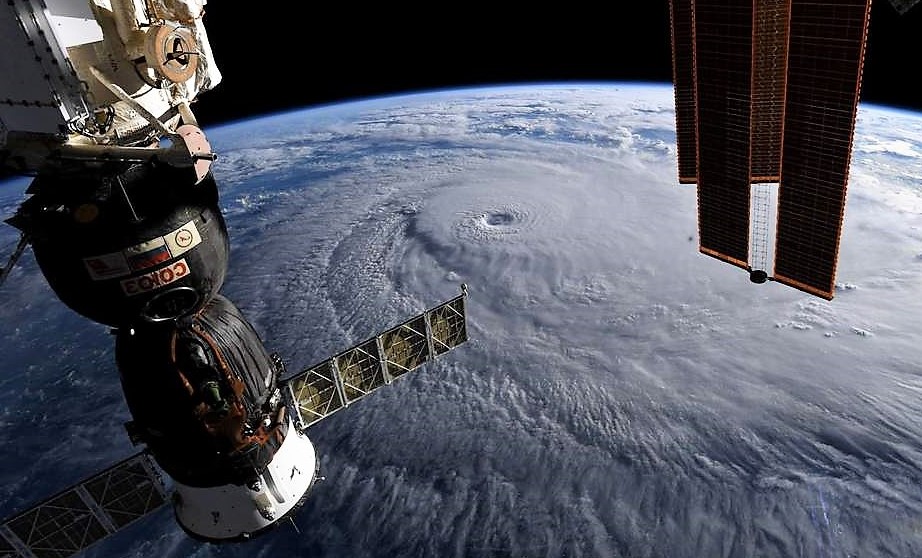Leak in Russian spacecraft
September 6, 2018 | Expert Insights

Russia’s space agency said on Wednesday it hopes to announce the origin of a small hole found on a Russian module docked at the International Space Station in the coming weeks, and also address whether the damage was deliberate.
Background
The International Space Station was intended to be a laboratory, observatory and factory in low Earth orbit. It was also planned to provide transportation, maintenance, and act as a staging base for possible future missions to the Moon, Mars and asteroids. In the 2010 United States National Space Policy, the ISS was given additional roles of serving commercial, diplomatic and educational purposes.
The ISS programme is a joint project among five participating space agencies: NASA, Roscosmos, JAXA, ESA, and CSA. The ownership and use of the space station are established by intergovernmental treaties and agreements. The station is divided into two sections, the Russian Orbital Segment (ROS) and the United States Orbital Segment (USOS), which is shared by many nations. As of January 2018, the American portion of ISS is being funded until 2025.
Rassvet, also known as the Mini-Research Module 1 (MRM-1) and formerly known as the Docking Cargo Module (DCM), is a component of the International Space Station. The module's design is similar to the Mir Docking Module launched on STS-74 in 1995. Rassvet is primarily used for cargo storage and as a docking port for visiting spacecraft.
Analysis
Crew members last week found a hole 2 millimetres in diameter in Soyuz MS-09, a spacecraft capsule docked to the space stations Rassvet module. It was found on the inner wall of the orbital space station after ground operators reported slight dips in pressure levels.
The current crew, consisting of three U.S. astronauts, two Russians and one German, were never in any danger, officials said. Russian cosmonauts patched the puncture with tape and sealant hours after its discovery, temporarily stopping an oxygen leak. Its origin, however, remains a mystery to U.S. and Russian space officials. Dmitri Rogozin, director of Russia’s space agency Roscosmos, said on Monday that a person could have deliberately penetrated the wall using a drill either during manufacturing or while the craft was in orbit.
The hole itself is the opposite to what one would expect from a micrometeor. It is a neat, round hole. “There is another version that we are not ruling out; that this was done deliberately in space,” Rogozin said. He indicated there were “several attempts to use a drill” by an “unsteady hand,” scraping the metal areas surrounding the hole, “We can cut short the idea that this was a technological mistake made by some specialist or other,” he added. The Russian space agency said the commission’s investigation will be completed in mid-September.
Roscosmos and RSC Energia, the module’s manufacturer, did not respond to multiple requests for comment.
A spokeswoman for the U.S. space agency, the National Aeronautics and Space Administration (NASA), declined to comment on the origin of the hole out of concern that doing so would intrude on Russia’s investigation. “We are confident they will identify the cause of the leak,” Stephanie Schierholz said in an email. However, she confirmed U.S. astronauts were aiding the investigation to “assess and ensure the safety of all crew members.”
But the Soyuz hole is curious. If it was created on Earth, how did it just now start leaking after two months in space? It’s possible that a technician on the ground drilled a hole in the wrong place, realized the mistake, and then tried to patch it up with something that just got dislodged last week.
If someone on board the craft did drill the hole, which is unlikely, it’s probably not malicious. Instead, suggests Russian politician Maxim Surayev, it could have been that someone resorted to an extreme measure to return to Earth. “We’re all human and anyone might want to go home, but this method is really low,” Surayev, who was on two previous missions to the ISS, told Russian state news agencies.
Counterpoint
This is not the first time that sabotage angle debated when investigating a spacecraft failure. In 2012, then-head of Roscosmos Vladimir Popovkin hinted that a foreign country may have been to blame for the failure of a Russian spacecraft Phobos-Grunt. The probe was supposed to explore one of the moons of Mars but instead got stuck in Earth’s orbit and eventually fell back to our planet.
When one of SpaceX’s Falcon 9 rockets exploded in 2016, the company said that it seriously considered sabotage by rival rocket company, the United Launch Alliance. Neither the SpaceX failure nor the Phobos-Grunt incident turned out to be sabotage.
Assessment
Our assessment is that a production error is a likely culprit since drilling a hole in zero gravity is extremely difficult or impossible. We feel that the craft was damaged during testing at the Baikonur Cosmodrome in Kazakhstan after passing initial safety checks, and someone hastily covered up the mistake. We also feel that the sealant used to cover the hole could have then dried and fallen off after the craft reached the ISS.








Comments